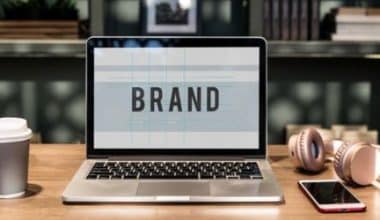Imagine you’re reading through your favorite magazine or scrolling through Instagram and coming across an advertisement with your favorite celebrity supporting a product. That product suddenly appears more enticing, doesn’t it? This is the mystical allure of celebrity endorsements.
Take Nike’s collaboration with Michael Jordan. The Air Jordan line, which began as a daring risk in the mid-1980s, has since become a cultural phenomenon. Today, it is more than simply a sneaker; it is a symbol of greatness, breaking down barriers, and generating $3 billion in revenue for Nike each year.
This kind of transformation is why celebrity endorsements can be so powerful for businesses. In this article, I’ll go deep into how you can harness star power to enhance your brand, boost credibility, and expand.
Key Takeaways
- Celebrity endorsement, also known as celebrity branding or celebrity advertising, is a marketing strategy that uses a celebrity’s fame and image to promote a brand or product
- When a trusted celebrity vouches for a brand, consumers are more likely to perceive it as credible and trustworthy, leading to increased brand loyalty.
- Research shows a clear correlation between celebrity endorsements and increased sales, making them a valuable investment for driving business growth.
- Tracking key performance indicators, analyzing return on investment, and adapting strategies based on performance data are crucial steps in ensuring the effectiveness of celebrity endorsement campaigns.
What is a Celebrity Endorsement?
Endorsement is a type of brand communication in which a celebrity serves as the brand’s spokesperson and validates the business’s claim and stance by extending his or her personality, fame, social standing, or knowledge in the industry to the brand. In a market with a large number of local, regional, and international businesses, celebrity endorsements were deemed to provide a particular advantage. However, throughout the years, many aspiring firms have gotten on the celebrity endorsement bandwagon. Even if sponsorships have reached quasi-industry status, few collaborations have been as successful as Nike’s.
A celebrity endorsement, also known as celebrity branding or celebrity advertising, is a marketing strategy that uses a celebrity’s fame and image to promote a brand or product. Other use cases include not-for-profit organizations that leverage a celebrity’s fame to raise awareness or funding around a cause. Or event marketers leveraging a celebrity’s fame and popularity to create buzz and prestige around their virtual or hybrid event
Who is a Celebrity Influencer?

A celebrity influencer can be any widely recognized person. Celebrities typically have at least 1 million followers on a given social media channel. They are sometimes also classified as mega- or macro influencers. In the United States, some of the leading celebrities include:
- Professional athletes
- Famous musicians
- Movie or TV stars
- Best-selling authors
- Business leaders
The world of celebrity-ism has broadened in the last few years, largely thanks to the rise of social media. Many digital creators have leveraged their unique talents to gain millions of engaged followers on leading social channels like Instagram, TikTok, and YouTube.
Celebrity Endorsement Essentials
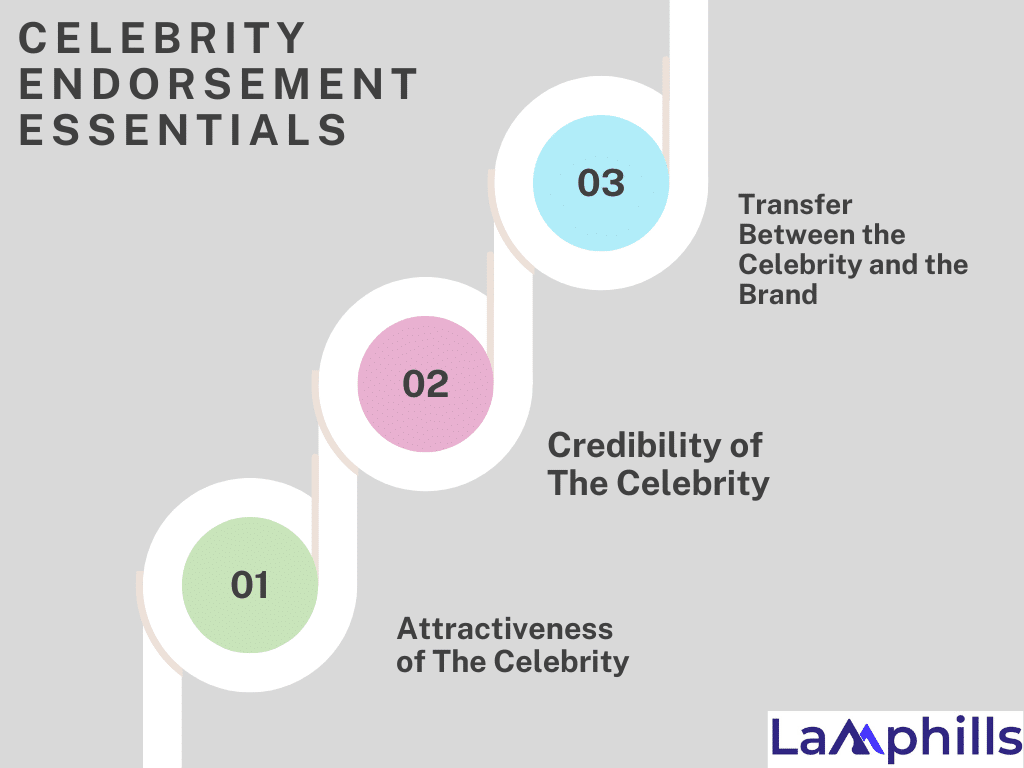
Even if it appears to an outsider that Nike’s success is predicated on Tiger Woods’ relationship with the company, this couldn’t be further from reality. Nike has developed a strong brand identity and personality over time. Nike uses celebrity endorsements as one of its primary methods for connecting with a highly targeted audience.
So Nike’s partnership with Tiger Woods was part of a larger branding strategy that Nike has constantly employed. In contrast, most firms that have employed celebrity endorsements have made it their primary brand-building tactic. Before any brand hires a celebrity, they should examine three key factors.
#1. Attractiveness of The Celebrity
This principle argues that an appealing endorser will have a beneficial effect on the endorsement. The endorser should be appealing to the target audience in areas such as physical attractiveness, intellectual ability, athletic competence, and lifestyle. It has been demonstrated that an endorser who appears appealing in the manner described above has a higher likelihood of increasing brand recall.
#2. Credibility of The Celebrity
This notion suggests that for any brand-celebrity relationship to be effective, the celebrity’s credibility is essential. Credibility is defined as a celebrity’s perceived skill and trustworthiness. Celebrity endorsements operate as an external cue that allows customers to sort through the massive brand clutter in the market. the credibility factor of the celebrity greatly influences the acceptance of consumers.
#3. Transfer Between the Celebrity and the Brand
This theory asserts that the success of a brand-celebrity partnership is strongly dependent on the brand and celebrity’s compatibility in terms of identity, personality, market placement relative to competitors, and lifestyle. When a brand signs a celebrity, these are some of the compatibility elements that must exist for the brand to get the most out of the relationship.
Even though organizations must adhere to these three fundamental standards, it may be difficult to identify celebrities who meet all three criteria. Companies can choose to highlight one component over another based on the nature of the brand and the type of product being used.
Types of Celebrity Endorsements
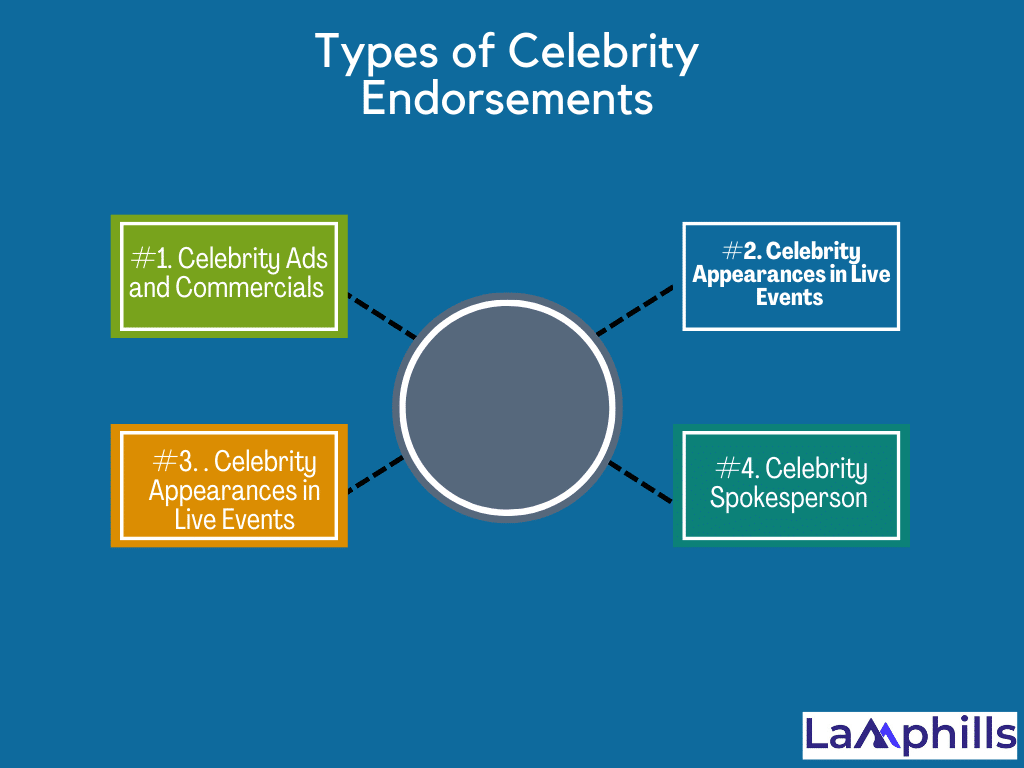
There are a few ways a celebrity can endorse your brand or product.
#1. Celebrity Ads and Commercials
These ads can appear as banners and videos for paid campaigns, on social media, or as video bumpers on YouTube. You can also go the more classic way and purchase commercial slots on television or have the celebrity host an infomercial rather than an ad.
#2. Celebrity Appearances in Live Events
Brands often invite celebrities to present a keynote or host their entire hybrid or virtual event. In their 2020 edition, Dreamforce to You went all-in with appearances by James Corden, Metallica, and Lenny Kravitz. More on this in the next section.
#3. Celebrity Signature Product Lines
Some brands put a celebrity name or face directly on their product. This is quite common in certain industries like music instruments (think the Fender Stratocaster Eric Clapton Signature model), clothing (the aforementioned and legendary Nike Air Jordans), or other products like Vitamin Water, to which 50 Cent lent his face.
#4. Celebrity Spokesperson
Celebrity spokesperson advertising is common in the not-for-profit sector and causes. The celebrity attracts attention while speaking in the name of the organization at third-party events and to the media.
Sometimes brands offer (mostly honorary) titles to their celebrities as part of the deal. Lady Gaga has a “day job” as the Creative Director for Polaroid. Justin Timberlake occupies the same position for golf brand Callaway. It must be great fun around the coffee machine. But it’s also a powerful statement for the consumer.
Examples Of Celebrity Endorsement Ads
For generations, celebrity endorsements have been a staple of advertising. Seriously. The first celebrities to endorse things were Roman gladiators, who recommended oils and wines to their supporters.
And little has changed over thousands of years. Brands continue to use celebrities’ tremendous amounts of love to raise awareness, improve sentiment, and increase sales for their products or services.
However, simply having a random celebrity be the face of your product will not guarantee sales. Instead, brands should focus on stars who adore their products, which will result in true endorsements.
It always pays to see what others have done to get a better idea of what you want and how you should go about executing your campaign. Here are some successful celebrity endorsement examples…
#1. Jameson and Regina Hall
Earlier this year, Jameson Irish Whiskey collaborated with actress Regina Hall to commemorate St. Patrick’s Day. The Girls Trip star teamed up with the brand to encourage fans to take the day off and celebrate the holiday. Through funny movies created by Lauren Palmigiano, Hall demonstrated how the customary Jameson “Desk Decoy” allowed her to navigate work while enjoying the holidays. Her real brand enthusiasm for Jameson made the collaboration a natural fit, helping the brand reach a younger, more diversified audience.
Furthermore, the brand’s pledge to donate all Desk Decoy revenues, as well as an additional $25,000 to the Restaurant Workers’ Community Fund, solidified their socially responsible relationship.
#2. Louis Vuitton and Rhianna
Just because you are conducting a menswear advertisement does not mean that promoting it is a man’s responsibility. Just ask Pharrell Williams, who collaborated with Rihanna for his debut Louis Vuitton menswear campaign, which promoted the premium brand’s new leather bag collection.
As a global superstar and fashion influencer, her appearance drew a lot of attention to the ad. Rihanna, who is pregnant with her second child, broke traditional maternity fashion rules by exhibiting bright and unique outfits. This approach was consistent with Williams’ creative vision beyond fashion, making a strong statement about breaking down borders and embracing individuality.
#3. Chanel and Timothée Chalamet
Chanel chose Timothée Chalamet as the face of their men’s fragrance, Bleu, to reflect the changing definition of masculinity in the beauty industry. Chalamet’s embrace of breaking gender conventions in his performances, as well as his distinct red-carpet style, resonated with audiences looking for a more fluid and inclusive period of style.
The collaboration capitalized on the growing trend of male celebrities and influencers embracing beauty and grooming, as makeup and gender-neutral companies gained popularity. The appointment of Chalamet might boost growth in the competitive men’s fragrance sector, which is predicted to reach $19.6 billion by 2025. Chanel’s early acceptance of makeup for men exemplifies the company’s commitment to diversity and personal expression.
#4. Versace x Dua Lipa
Dua Lipa recently teamed with Donatella Versace to co-design Versace’s ‘La Vacanza’ collection, which is high summer and holiday-inspired. Dua Lipa, a longstanding Versace acquaintance, adds legitimacy and excitement to the collection with her star power and true passion for the brand.
Versace saw this cooperation as a smart move to reach a larger audience, using Dua Lipa’s global impact and popularity in the music industry. Versace reached out to Dua Lipa’s devoted following by merging design and music. At the same time, the pop sensation was able to accomplish her ambition of designing and empowering women through her collaboration with the fashion powerhouse.
#5. Under Armour x Steph Curry
Armour’s agreement with Steph Curry is another win-win situation for all parties. For starters, Curry gets to create his own distinctive basketball shoe line, which has become a huge success for the brand. But it’s not all about the shoes. Curry also receives stock options from the corporation, which ties his performance to the company’s.
On the other hand, Under Armour gains an all-time great for their squad, which enhances credibility among basketball fans and helps the brand compete in a tough sportswear market.
Overall, Curry’s work with Under Armour is more than just an athlete endorsement; it exemplifies a true partnership that benefits both sides and has added to his popularity as an athlete and fashion star.
How to Get Celebrity Endorsements
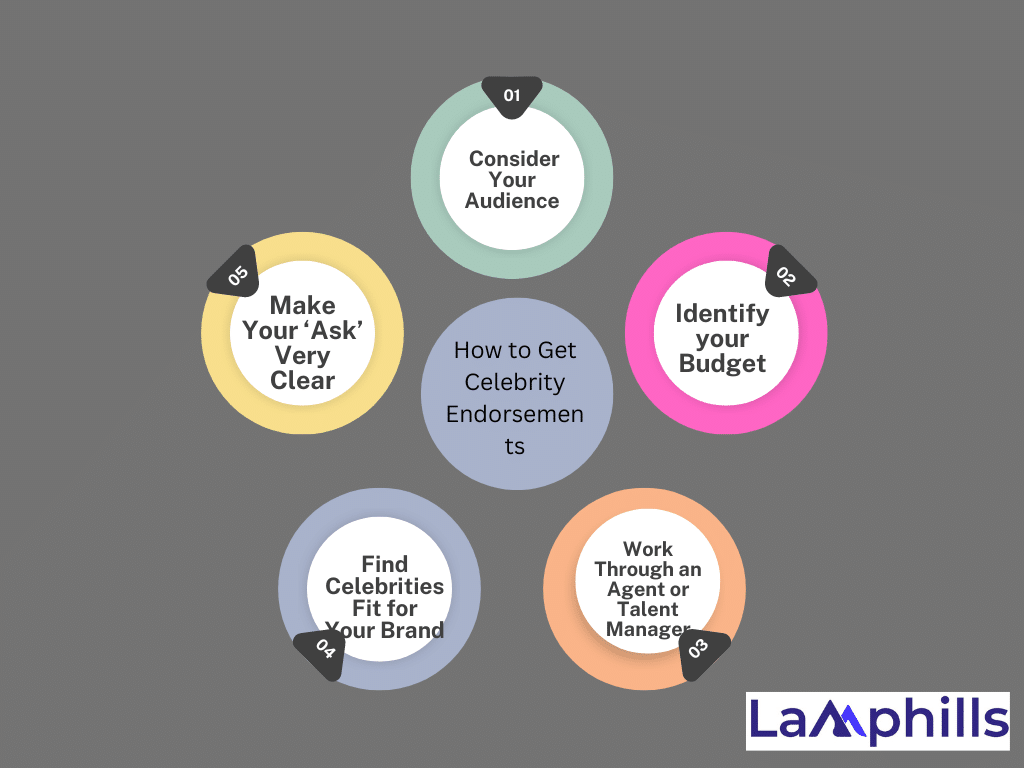
Choosing the right celebrity to endorse your brand is similar to choosing the ideal partner: it’s all about chemistry. A mismatch might result in a marketing disaster, yet the correct fit can produce magic. Let’s get into the complexities of choosing the appropriate celebrity for your brand.
#1. Consider Your Audience
Consider the last time you attended a concert. The musicians on stage weren’t just performing; they were engaging with you and hundreds of other people who share your interests. This relationship is important for celebrity endorsements as well.
Understanding your target audience and what they connect with is critical when selecting the perfect celebrity. Psychographics—hobbies, values, and lifestyle choices – are just as essential as demographics like age, gender, geography, and income level.
Take Selena Gomez’s cooperation with Coach, for example. Coach, a business looking to re-energize its appeal to younger consumers, found the ideal partner in Gomez. Her flair, charm, and relatability to young adults made her an excellent spokesman. What was the result? A revamped brand image and a considerable increase in sales among younger consumers.
However, there are pitfalls in not knowing your audience. When Madonna was chosen to promote Pepsi in the 1980s, her edgy image didn’t resonate well with Pepsi’s more conservative customer base at the time. The backlash was swift, and the ad was pulled, illustrating the importance of demographic alignment.
#2. Identify your Budget
Know what you can reasonably afford, set a strict budget, and don’t exceed it. Start small when negotiating and work your way up to your highest figure. Don’t worry too much if you can’t work out a deal that fits your budget with a particular creator. You can always sacrifice a few thousand followers for a partnership that works better financially.
#3. Work Through an Agent or Talent Manager
There is no point in attempting to contact a celebrity personally. Even if you manage to obtain that person’s email or phone number, sending a cold outreach message will not get you very far unless you already have a relationship with them.
Great celebrity endorsement deals are done through celebrity agents or managers. dealing with an agent in the early stages of recruitment is as close to dealing directly with the celebrity as you can get, and that’s fine.
It’s also important to distinguish between agents/talent managers, and influencer marketplaces. Influencer marketplaces do not benefit celebrities; they just facilitate transactions between businesses and influencers. Agents, on the other hand, only represent their clients because celebrities do not have time to respond to every brand’s offer.
#4. Find Celebrities Fit for Your Brand
When seeking a celebrity collaboration, prioritize your brand’s goal, vision, and values. Working with like-minded individuals ensures that your audience understands who you are and what you stand for. The best-case situation is to identify a celebrity who is already using your product. If that is not an option, offer the maker some free items ahead of time and let them decide whether it is something they would use in real life.
When evaluating a celebrity’s potential effect, it’s tempting to be charmed by their sheer number of followers. However, it is not only important to reach a large number of people but also to affect them deeply. Engagement rates—likes, comments, and shares—are significant markers of how connected a celebrity is to their followers.
Consider Cristiano Ronaldo, who has more than 500 million social media followers. Brands respect not only his vast reach but also his high engagement and influence. When Ronaldo moved a couple of Coca-Cola bottles during a Euro 2020 news conference, preferring water, Coca-Cola’s stock price reportedly fell. This episode demonstrated his strong power on public image and customer behavior.
Tools for measurement:
- SocialBlade and HypeAuditor: These platforms analyze follower growth, engagement rates, and audience demographics, providing a clear picture of a celebrity’s social media impact.
- Google Trends: Useful for tracking a celebrity’s popularity over time and their influence on public interest.
- Klear: offers insights into a celebrity’s influence across various social media platforms and helps identify the best influencers for your brand.
#5. Make Your ‘Ask’ Very Clear
When our celebrity endorser became embroiled in a legal dispute while I was handling marketing for a beverage company, we were in a pickle. Fortunately, our contract included a moral clause that permitted us to leave the partnership without incurring financial penalties. This insight rescued our business from any negative consequences and underlined the necessity of protecting your brand through strong legal agreements and ongoing reputation monitoring.
To develop a solid relationship, you should understand what you want the individual to do, how long the partnership will last, what items you want to promote, and what the remuneration package will be. Keep in mind that celebrities are professionals who expect the same level of treatment from the brands with which they collaborate. Providing thorough briefings and campaign goals is a is a great way to show you’re legit.
Mitigating Risks:
- Moral Clauses: Include provisions in contracts that allow termination if the celebrity engages in behavior that could negatively impact the brand.
- Diversification: Consider multiple endorsements to spread risk. If one partnership goes awry, the impact on your brand is minimized.
- Reputation Monitoring: Use tools like Mention and Brandwatch to keep tabs on the celebrity’s public image and swiftly address any issues that arise
#6. Aligning Brand and Celebrity Values
Imagine you’re at a family reunion, and Aunt Linda chooses to introduce you to someone she believes you’ll get along with. They share your passion for travel, value your eccentric sense of humor, and have comparable life aspirations. You instantly feel a connection since your values are similar. The same logic applies when choosing a celebrity for your brand.
For a celebrity endorsement to be effective, the chosen star’s image and values should reflect those of your brand. This connection promotes authenticity and trust. For example, when Nike collaborated with Colin Kaepernick, the campaign was more than just promoting shoes. It was about standing up for something bigger: social justice. Nike’s brand attitude of questioning norms and pushing limits aligned nicely with Kaepernick’s stance on equality and justice. Despite the controversy, the campaign deeply connected with a significant segment of Nike’s audience, showcasing how powerful value alignment can be.
In other words, choosing the right celebrity for your brand is not just about finding someone famous. It’s about finding someone who embodies your brand’s values, resonates with your audience, possesses genuine influence, and carries manageable risks. By considering these factors, you can create powerful, authentic endorsements that drive significant business growth.
Measuring the Success of Celebrity Endorsements
Celebrity endorsements are a substantial expenditure for any brand, and assessing their effectiveness is critical to ensuring that the investment is worthwhile. Effective measurement is critical for tracking key performance indicators (KPIs), measuring return on investment (ROI), and altering strategy in response to performance. Let us investigate these issues in depth, using personal tales and real-world examples to demonstrate their significance.
#1. Key Performance Indicators (KPIs)
Imagine you’re driving a car without a dashboard – you have no idea how fast you’re going, how much fuel you have left, or if there’s a problem under the hood. Tracking KPIs in celebrity endorsements is like having that dashboard – it gives you vital insights into how your campaign is performing.
Essential KPIs:
- Engagement: This metric assesses how actively the audience interacts with your campaign. To determine engagement levels, consider measures such as likes, comments, shares, and retweets. For example, if a celebrity’s Instagram post featuring your product receives thousands of likes and comments, it indicates high engagement.
- Reach: This refers to the size of your campaign’s audience. It tells you how many people have seen your endorsement. Tools such as Google Analytics and social media analytics provide information on reach across multiple platforms.
- Brand Sentiment: This metric measures how the audience perceives your brand following the endorsement. Analyze social media mentions, comments, and sentiment analysis techniques to determine whether the endorsement positively impacted brand perception.
- Sales Lift: Ultimately, the bottom line is what matters most. Track changes in sales before, during, and after the endorsement to measure its direct impact on revenue.
Tools for monitoring:
- Google Analytics: provides comprehensive insights into website traffic, conversions, and user behavior.
- Social Media Analytics: Platforms like Facebook Insights, Twitter Analytics, and Instagram Insights offer data on engagement, reach, and audience demographics.
- Sentiment Analysis Tools: Tools like Brandwatch and Mention analyze social media mentions to gauge sentiment and brand perception.
#2. ROI Analysis
Celebrity endorsements are a significant financial commitment, and assessing their ROI is essential to determine whether they’re delivering value for your brand.
- Calculating ROI:
ROI = (Net Profit from Endorsement – Cost of Endorsement) / Cost of Endorsement
- Interpreting ROI:
A positive ROI indicates that the endorsement generated more revenue than it cost, making it a worthwhile investment. However, it’s essential to consider other factors, such as brand visibility and long-term impact, beyond immediate sales.
- Instances:
a.Nike and Michael Jordan: Nike’s long-term partnership with Michael Jordan is a textbook example of high ROI. Despite the initial skepticism around the hefty endorsement deal, the Air Jordan brand has become a billion-dollar empire, generating massive returns for Nike over the years.
B. Samsung and BTS: Samsung’s collaboration with the K-pop sensation BTS resulted in a significant boost in brand visibility and sales, particularly in the smartphone market. The endorsement not only drove immediate sales but also strengthened Samsung’s connection with younger consumers, leading to long-term brand loyalty. Here are a few factors contributing to the high ROI you make make use of,
- Alignment with Brand Values: Endorsements that resonate with the brand’s values and messaging tend to yield higher returns.
- Authenticity: Genuine endorsements that feel natural and sincere are more likely to drive consumer trust and loyalty.
- Multi-Platform Integration: Campaigns that leverage multiple channels effectively can maximize reach and impact, leading to higher ROI.
#3. Adjusting Strategies Based on Performance
Monitoring performance metrics and ROI is not enough – it’s essential to use this data to refine and optimize your endorsement strategies for better results.
- Utilizing Performance Data:
Identify Strengths and Weaknesses: Analyze performance data to identify what worked well and what didn’t in your endorsement campaign.
Iterative Improvement: Use insights from performance data to make incremental adjustments to your strategies. This could involve refining targeting, messaging, or platform selection.
Stay Agile: The marketing landscape is dynamic, so be prepared to adapt your strategies based on changing trends, audience preferences, and competitive dynamics.
- Examples of adaptation:
Coca-Cola’s Share a Coke campaign began with popular names on bottles and eventually expanded to incorporate customizable labels and social media interaction. This iterative approach based on consumer answers led to the campaign’s long-term success.
Old Spice’s Response Campaign: Initially aimed at men, Old Spice’s “The Man Your Man Could Smell Like” campaign was eventually expanded to incorporate amusing social media replies from customers. This real-time engagement strategy is built on the campaign’s success, increasing brand awareness and engagement.
Measuring the success of celebrity endorsements requires more than just tracking numbers; it’s about understanding the impact of your investment and then using that knowledge to develop and optimize your strategies for better results. Brands can maximize the value and effect of their celebrity connections by analyzing KPIs, calculating ROI, and modifying strategy depending on performance.
Challenges and Considerations in Celebrity Endorsements
Celebrity endorsements can propel your brand to new heights, but they also come with challenges. There’s a lot to consider, from managing costs to navigating public relations crises and ensuring legal compliance.
#1. Cost and Budgeting
Imagine you’re planning a road trip. You have to budget for fuel, accommodations, and food to ensure a smooth journey. Celebrity endorsements are quite similar in that they require meticulous financial planning and budgeting to avoid surprises down the road.
Understanding Costs:
- costs and compensation: celebrity costs can range from thousands to millions of dollars, depending on their notoriety and the size of the campaign. For example, when George Clooney became the face of Nespresso, he reportedly received a $40 million fee. While this may be reasonable for a worldwide brand, it is a significant investment for smaller enterprises.
- Production expenditures: In addition to the celebrity’s salary, you should budget for campaign production expenditures. This involves producing commercials, photo sessions, social media material, and event appearances. A Super Bowl ad, for example, can cost up to $5 million to produce, even before paying the celebrities.
- Marketing and Promotion: After production, there’s the cost of distributing and promoting the campaign across various channels. This could include TV air time, social media boosts, and print ads.
Budgeting Tips:
Define Your Budget Early: Before approaching celebrities, set a clear budget. This helps to establish reasonable expectations and prevents financial overspending.
Prioritize ROI: Concentrate on endorsements that provide the biggest return on investment (ROI). Consider the potential influence on brand visibility, sales, and engagement.
Negotiate Wisely Never be afraid to negotiate. Celebrities and their agencies frequently have some leeway, particularly if the endorsement complements their image or if the campaign provides major publicity.
#2. Managing Public Relations
Celebrity endorsements can sometimes be a double-edged sword. While they bring fame and attention, they also carry the risk of negative publicity. Managing public relations effectively is crucial to safeguarding your brand. When a celebrity endorser is involved in a scandal, it can quickly reflect on your brand. Remember the Tiger Woods saga? After his personal life issues came to light, several of his sponsors, including Accenture and AT&T, cut ties to protect their reputations.
Crisis Management Strategies:
a. Monitor Public Perception: Use tools like Brandwatch or Mention to keep an eye on the celebrity’s public image and the sentiments around your brand. Being aware of potential issues early allows you to act swiftly.
b.Have a Crisis Plan: Develop a crisis management plan detailing how to handle negative publicity. This plan should include predefined statements, a list of decision-makers, and a strategy for communicating with the public and stakeholders.
c.Be transparent: If a controversy arises, address it directly and honestly. Transparency helps maintain trust. When Nike faced criticism for its campaign with Colin Kaepernick, the company stood by its decision, emphasizing its commitment to supporting bold moves for social change. This stance, although divisive, strengthened its connection with a significant portion of its audience.
#3. Legal and Contractual Issues
When entering into a celebrity endorsement agreement, the devil is often in the details. Legal and contractual issues can be complex, but understanding and managing them is essential to protecting your brand.
Key Legal Considerations:
- Moral Clauses: These clauses provide you with the right to terminate the contract if the celebrity engages in behavior that could affect your brand’s image. They are critical for reducing the dangers connected with public figures’ unpredictable behavior.
- Exclusivity Agreements: Determine whether the celebrity may endorse competitor products. For example, when LeBron James supports Nike, you can be sure he will not promote Adidas. Exclusivity increases the relationship between the celebrity and your brand, but it usually comes at a higher cost.
- Usage Rights: Clearly state how and where the celebrity’s image may be used. This includes determining the campaign’s platforms, duration, and geographic reach. For example, if you intend to use a celebrity’s endorsement in both digital and print media, make sure these rights are specifically indicated in the contract.
- Performance Metrics: Outline any performance-related conditions in the contract, such as a minimum number of social media posts or appearances. This ensures you get the engagement level you’re paying for.
Compliance and Protection Tips:
Always have a legal expert analyze endorsement contracts to ensure that any possible difficulties are addressed and your brand is safeguarded.
Set clear terms: Define all components of the agreement, including payments, usage rights, and termination terms. Ambiguity can lead to disagreements.
Regular Reviews: Periodically evaluate the contract and the celebrity’s performance to ensure compliance and fix any concerns that arise.
Celebrity endorsements can provide tremendous chances for business growth, but they also present considerable obstacles. You may handle these difficulties and maximize celebrity power by carefully managing costs, anticipating PR problems, and assuring legal compliance. With the correct technique, your brand may shine brilliantly in the spotlight, just like the superstars that promote it.
Strategies for Effective Celebrity Endorsements
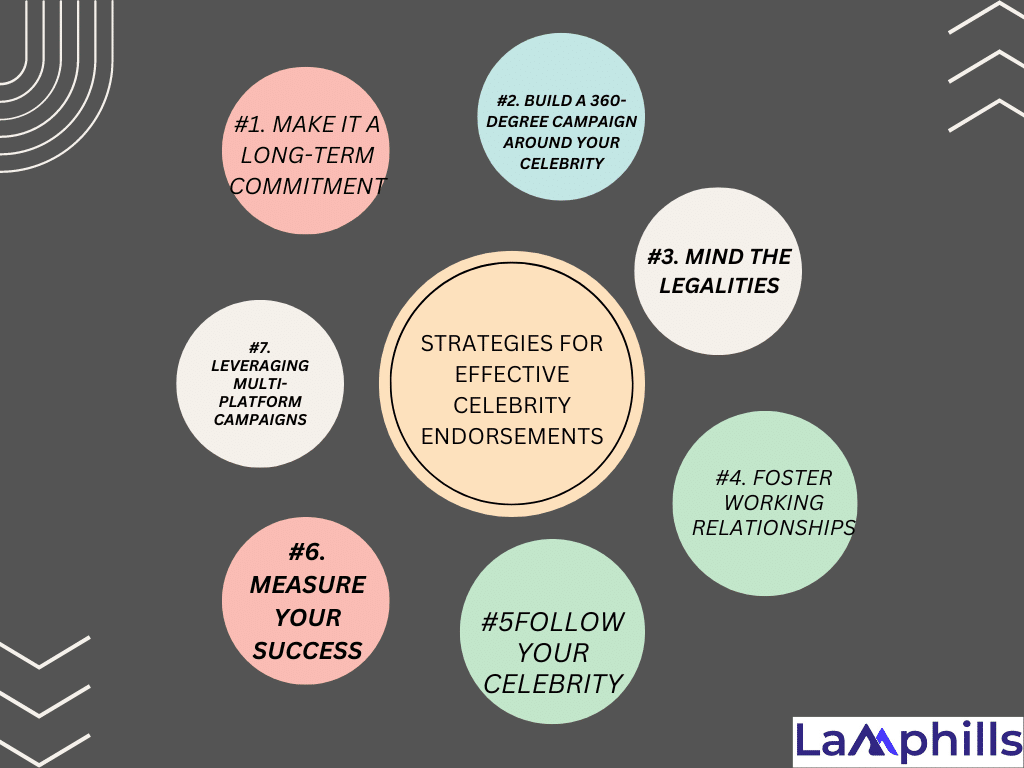
Celebrity endorsements can be a game-changer for your brand, but the strategy behind them is crucial. I’d like to complete that list of best practices with guidelines to get the most out of your celebrity endorsement:
#1. Make it a Long-Term Commitment
When it comes to celebrity endorsements, the duration of the partnership is a critical factor. Should you go for a long-term deal that builds a deep, lasting association, or a short-term campaign that creates a quick impact?
- Long-term Partnerships
- Pros: They build a strong and lasting association between the celebrity and the brand. Michael Jordan’s lifetime deal with Nike is the gold standard here. This enduring partnership has created a brand within a brand, with the Air Jordan line becoming synonymous with excellence and performance.
- Cons: Long-term deals can be risky if the celebrity’s public image changes negatively. They also require a significant investment and commitment from both parties.
- Short-term Campaigns
- Pros: They are flexible and can be tailored to specific promotions or events. For example, Gucci’s collaboration with Harry Styles for a single season generated tremendous buzz without a long-term commitment. Short-term deals are less risky and allow for quick adaptation to changing market trends.
- Cons: The impact may be short-lived, and the brand may need to constantly seek new endorsements to maintain momentum.
That is to say, It’s good practice to view celebrity endorsements as a long-term strategy. It takes time for the audience to connect the celebrity with the brand and identify them with each other (think Clooney’s long-term partnership with Nespresso). Especially if you’re using celebrity endorsements as a strategy to attract new audiences or reposition your brand.
#2. Build a 360-Degree Campaign Around your Celebrity
Authenticity is the key component that makes an endorsement campaign resonate. It is important to make the audience feel as though the partnership is natural and believable.
Consider Oprah Winfrey’s relationship with Weight Watchers. Oprah’s honest journey with weight loss made her endorsement feel genuine and accessible. Her enthusiasm was not simply about pushing a product; it was about conveying a personal tale that resonated with many people’s challenges. This legitimacy boosted Weight Watchers’ shares by more than 100% following the announcement.
Take a peek at the infamous Pepsi ad with Kendall Jenner. The advertisement attempted to get into the social justice movement, but it felt manufactured and trivialized serious topics. The criticism was fast and intense, emphasizing how important authenticity is in celebrity endorsements.
Celebrity marketing is a costly endeavor. You’re going to want to do more with it than just put out a quick video for a paid campaign. Get ready to roll all your marketing muscles and create a big splash:
- Video ads and bumpers for YouTube and other social platforms
- Banners for paid campaigns on social media and Google
- BTS posts on blogs and social media (articles, photos, and videos)
- Videos banners and assets on the company website
- Internal campaigns for employees (employee advocacy, merch, events, etc.)
- Email campaigns
- Press releases
#3. Mind the Legalities
Here is a checklist you can always refer to
Legalities make celebrity branding very different from any other type of marketing campaign. You will be dealing with complicated contracts, agents, and unions. Make sure to have your legal team on board, but consider hiring external consultants who have experience with celebrity projects.
#4. Foster Working Relationships
A celebrity endorsement is an intense collaboration between quite a few parties that all have their own agendas and requirements. And Hollywood agents are notorious for being tough cookies when it comes to protecting their celebrity’s image and career. Taking the time to build trust and rapport with all the involved parties will go a long way.
#5. Follow Your Celebrity
There is no need to stalk your celebrity, but you do want to keep tabs on their behavior and actions, to make sure they stay in line with your company values. You should include a clause in your contract that offers a solution for these kinds of contingencies.
#6. Leveraging Multi-Platform Campaigns
In today’s interconnected world, a single channel strategy is no longer adequate. Integrating a celebrity endorsement across numerous media is essential for maximizing its impact. This method guarantees that the message reaches the target audience wherever they are, resulting in a unified and effective campaign.
When Pepsi collaborated with Beyoncé, the endorsement was more than just one commercial. The campaign featured television commercials, social media material, print advertisements, and even a magnificent Super Bowl halftime show. This multi-platform approach not only kept Pepsi in the public eye, but it also resulted in a consistent brand experience across several touchpoints. The integration of many media channels increased the campaign’s reach and engagement, making it a notable success.
Tips for Effective Multi-Platform Campaigns:
- Consistent Messaging: Ensure the core message is consistent across all platforms. This reinforces the campaign’s theme and strengthens brand recognition.
- Tailored Content: Adapt the content to fit the platform. What works on Instagram might not work on TV or in print. Customize the message to suit each medium while maintaining the overall theme.
- Synchronized Launch: Coordinate the timing of content releases across channels to create a wave of excitement and maintain momentum.
#7. Measure Your Success
There’s no easy and clear metric for your celebrity campaign performance, but it’s important to evaluate the quantitative and qualitative effect of the endorsement on your brand, lead generation, and sales. If possible, don’t schedule your celebrity campaign at the same time as other major campaigns or known seasonal performance fluctuations, so that you can isolate the performance of your celebrity branding and better calculate your ROI.
The Impact of Celebrity Endorsements on Business Growth
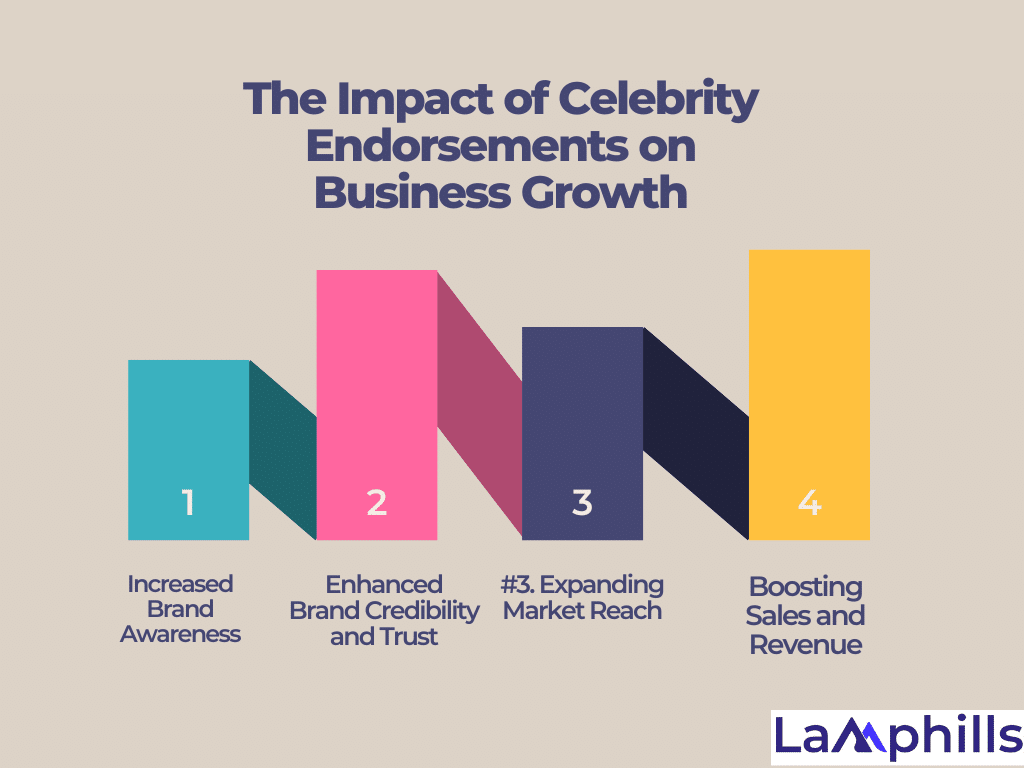
Celebrity endorsements have the power to catapult brands into the spotlight, driving significant growth and success. From increasing brand awareness to enhancing credibility, expanding market reach, and boosting sales and revenue, the impact of celebrity partnerships on business growth is undeniable. Let’s explore these aspects in depth, weaving in personal anecdotes and real-world examples to illustrate the transformative power of celebrity endorsements.
#1. Increased Brand Awareness
In a prior position, I observed firsthand the transforming power of celebrity endorsements on brand awareness. Our organization worked with a renowned social media influencer known for her fashion sense. Within days of her endorsement, our company experienced an increase in internet mentions, website traffic, and social media followers. The celebrity’s endorsement served as a beacon, bringing attention to our company and placing us on the map in our industry.
Imagine your brand is a little fish within a large ocean of competition. Suddenly, a spotlight shines down, illuminating your brand for everyone to see. That is the power of celebrity endorsements: they may significantly raise your brand’s awareness overnight.
- Case Studies:
Oprah Winfrey and Weight Watchers: When Oprah Winfrey became a spokesperson for Weight Watchers, the brand’s visibility increased significantly. Oprah’s endorsement not only raised awareness of the weight loss program but also sparked conversations and media coverage, resulting in a significant increase in brand awareness.
Apple and Justin Long: The “Get a Mac” campaign, which portrayed actor Justin Long as the personification of a Mac computer, helped propel the brand to new heights. Long’s portrayal of the cool, hip Mac user captured the imaginations of consumers all over the world, significantly increasing Apple’s brand recognition and market share.
#2. Enhanced Brand Credibility and Trust
Consumers are inherently mindful in an advertising-filled society. However, when a well-known celebrity endorses a brand, it can help boost credibility and trust. Trust me, this has a psychological impact: the phenomenon known as the “celebrity halo effect” shows that consumers transfer their positive thoughts about a celebrity to the endorsed brand. This psychological linkage can boost brand credibility and trust in the eyes of customers.
- Examples:
George Clooney and Nespresso: Nespresso’s partnership with George Clooney not only boosted brand visibility but also enhanced its credibility as a premium coffee brand. Clooney’s suave persona and genuine enthusiasm for the product helped establish Nespresso as a must-have luxury item for coffee connoisseurs.
Dove and Real Women: Dove’s “Real Beauty” campaign featuring real women instead of professional models resonated deeply with consumers. By showcasing diverse and authentic representations of beauty, Dove earned trust and credibility, positioning itself as a brand that celebrates individuality.
#3. Expanding Market Reach
One of the most significant advantages of celebrity endorsements is their potential to help firms reach new audiences and markets. Celebrities frequently appeal to a wide range of demographics, making them ideal friends in broadening their marketing reach.
For example, Pepsi’s collaboration with Beyoncé reached audiences all over the world. Beyoncé’s global appeal enabled Pepsi to enter new areas and connect with varied customer demographics, resulting in increased revenue and market share.
David Beckham and H&M: H&M’s collaboration with David Beckham increased the brand’s prominence while also allowing it to acquire traction in international markets. Beckham’s global celebrity and fashion hero status made him an effective spokesperson for H&M, luring customers from all over the world.
#4. Boosting Sales and Revenue
At the end of the day, the influence on sales and revenue is the ultimate measure of a business’s performance. Celebrity endorsements are directly related to higher sales, making them an important asset for boosting business success.
This is because multiple studies have demonstrated that celebrity endorsements increase sales and revenue. According to research, people are more likely to buy products promoted by celebrities they admire, resulting in a significant increase in brand sales and profitability.
Finally, celebrity endorsements have a significant impact on business growth, ranging from increased brand awareness and legitimacy to expanded market reach and increased sales and revenue. Brands can leverage celebrity influence and attractiveness to achieve remarkable success and cement their position in the market. As the saying goes, sometimes it takes a star to make a brand shine.
Who is the Most Endorsed Celebrity?
No one actor holds the title for most endorsements. However, there are several actors known for having numerous high-profile endorsement deals, including, Dwayne Johnson, George Clooney, and Jennifer Anniston, to name a few.
What is an Example of a Celebrity Product Endorsement?
A good example of celebrity endorsements is Under Armour’s partnership with Steph Curry. In this collaboration, Curry designed his basketball shoe line, which led to major sales for the brand. On the other hand, this athlete star gets stock options from the company, tethering his success to the company’s.
What is the Role of Celebrity Endorsers in Advertising?
The role of celebrity endorsements in TV commercials is multifaceted: they draw attention, lend credibility, and shape a brand’s image. However, they must be handled with care and strategic foresight.
What Makes a Good Celebrity Endorser?
A celebrity with a strong engagement rate (that is, comments or likes) on their posts. For example, if a celebrity has 5 million followers but only receives 5,000 likes or comments per post or video, their engagement rate is 0.1% – not great.
Conclusion
Celebrity endorsements are effective marketing strategies that can drastically raise a brand. The advantages range from raising awareness and reputation to enhancing sales and market reach. However, the secret to success is a deliberate strategy: selecting the proper celebrity, creating authentic marketing, and constantly measuring and refining your approach.
So, start small, assess the impact, and then grow your efforts if your company is ready to capitalize on celebrity endorsements. With good preparation and execution, harnessing celebrity for business growth can revolutionize your brand’s fortunes, as it did for Nike with Michael Jordan.
References
- corp.kaltura.com
- grin.co/blog
- brandingstrategyinsider.com
- www.forbes.com



